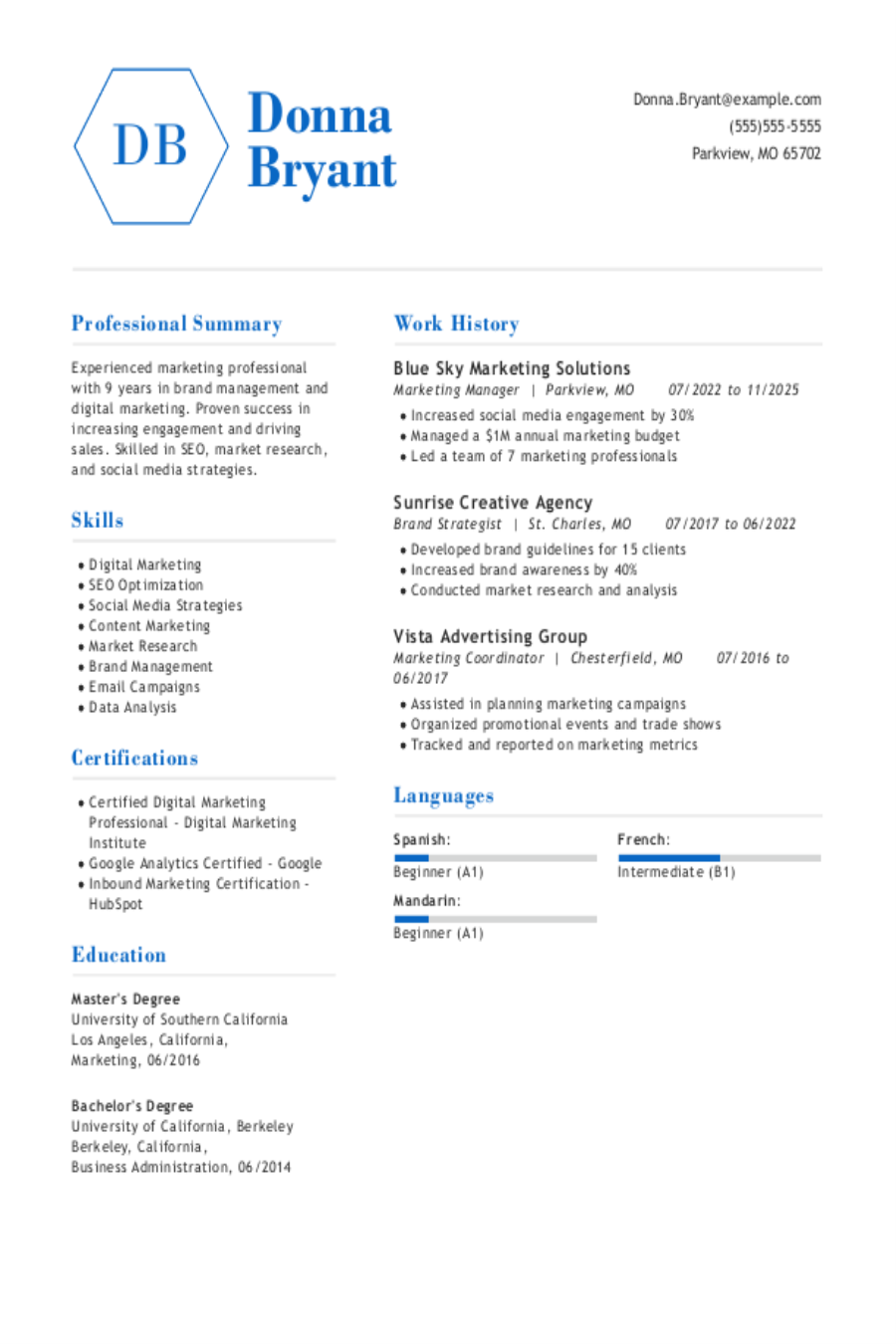Popular Artist Resume Examples
Entry-level artist resume
An entry-level resume for an artist should focus on showcasing artistic skills, relevant coursework, exhibitions, and any freelance projects to highlight creativity and potential despite limited professional experience.
Focuses on goals: The applicant demonstrates a proactive approach to their artistic career, emphasizing achievements and artistic exhibitions while continuously seeking opportunities for creative growth and professional development.
Prioritizes simplicity: Using a simple resume template, you can transform your resume into an easy-to-scan document. This approach helps recruiters quickly identify your qualifications.
Mid-career artist resume
A mid-career artist's resume should effectively showcase a rich portfolio, diverse skills, and notable achievements to reflect their artistic growth and versatility in the creative industry.
Uses active language: Using action verbs like "designed," "curated," and "directed" highlights leadership and significant achievements and gives this letter a sense of energy and motivation.
Leads with a strong professional summary: A well-written professional summary highlights the artist's extensive experience and skills, allowing recruiters and ATS to quickly pinpoint essential qualifications at a glance.
Experienced artist resume
An experienced artist's resume should prioritize showcasing a diverse portfolio, highlighting key exhibitions and collaborations, while clearly illustrating artistic evolution and professional milestones throughout their career.
Uses a traditional resume format: The chronological resume format effectively showcases this artist's extensive experience, illustrating their career trajectory and accomplishments in various artistic roles while helping readers understand their growth and contributions over time.
Uses an organized template: The resume uses a sleek template that combines a sophisticated header with an ATS-friendly resume layout, ensuring it appeals to both hiring managers and automated systems while highlighting the job seeker's artistic strengths.
No experience artist resume
A resume for an applicant with no experience should focus on highlighting relevant skills, volunteer work, and any artistic projects to showcase creativity and potential value to prospective employers in the art industry.
Uses straightforward language: Job seekers often feel the need to embellish their experiences with industry jargon, which can obscure their true capabilities. Even an artist with niche skills is best served by a simple resume that employers can understand at a glance.
Emphasizes professional skills: By emphasizing creative problem-solving and artistic vision, this job seeker demonstrates readiness for the role, showcasing their abilities despite limited professional experience in the field.
More resume examples
Additional Guides
- Artist
- Banking
- Biotech
- Budtender
- Business
- Business Operations
- Cashier
- Chef
- Chemistry
- College
- Communications
- Computer
- Computer Science
- Construction
- Consultant
- Cook
- Customer Service
- Customer Success Manager
- Cyber Security
- Dentistry
- Driving
- ECommerce
- Engineering
- Entry Level
- Esthetician
- Executive
- Federal
- Firefighter
- Food Service
- Government
- Graduate
- Graphic Designer
- Handyman
- Healthcare Support
- High School Student
- Hospitality
- Human Resources
- Industrial Engineering
- Insurance
- Interior Design
- Internship
- IT
- Law
- Manager
- Marketing
- Medical
- Military
- Music
- Nursing
- Performing Arts
- Pharmacy Technician
- Photographer
- Physical Therapy
- Pilot
- Product Manager
- Product Owner
- Production Assistant
- Program Manager
- Project Manager
- Psychology
- Radiologic Technologist
- Real Estate
- Restaurant Manager
- Retail
- Sales
- Sales Associate
- Scholarship
- Server
- Skilled Trades
- Social Services
- Software Engineer
- Stay At Home Mom
- Student
- Supervisor
- Teacher
- Teen
- Training Development
- Ux Designer
- Virtual Assistant
- Waitress
Artist Resume Template
Looking to showcase your creative talent? This artist resume template provides a solid foundation—just personalize it with your unique skills and experiences to make it truly yours.
Min Miller
Riverview, FL 33583
(555)555-5555
Min.Miller@example.com
Professional Summary
Dynamic artist with 8 years of experience delivering creative solutions. Skilled in digital illustration, curation, and client engagement. Achieved notable growth in audience reach and satisfaction.
Work History
Artist
Canvas & Co. - Riverview, FL
January 2022 - August 2025
- Created 50+ bespoke art pieces annually
- Grew client base by 30% through digital channels
- Curated monthly exhibitions increasing gallery visits
Art Instructor
Creative Minds Studio - Miami, FL
January 2018 - December 2021
- Developed curriculum for 100+ students
- Increased student engagement by 25%
- Hosted annual student showcases raising K
Illustrator
Visionary Designs - Miami, FL
January 2016 - December 2017
- Completed 200+ illustrations for diverse clients
- Enhanced project delivery speed by 20%
- Contributed to a 15% increase in client satisfaction
Skills
- Digital Illustration
- Conceptual Art
- Portfolio Development
- Exhibition Curation
- Art Instruction
- Client Management
- Visual Storytelling
- Creative Collaboration
Certifications
- Certified Professional Artist - National Art Society
- Advanced Techniques in Painting - Creative Education Institute
Education
Parsons School of Design New York, New York
June 2015
Bachelor of Arts Art History
University of California, Los Angeles Los Angeles, California
June 2013
Languages
- Spanish - Beginner (A1)
- French - Beginner (A1)
- Italian - Beginner (A1)
Must-Have Skills on an Artist Resume
A strong skills section is important for showcasing your talents and making a memorable impression on potential employers.
Creative and design professionals transform ideas into visual experiences that engage and captivate. The skills you highlight should show how you bring originality and thoughtful insight to projects. Your resume lets you demonstrate your role in shaping meaningful, memorable work that supports broader goals.
The following data highlights the most sought-after hard and soft skills for artists, derived from Resume Now’s extensive resume database.
When you’re ready to improve your resume with relevant skills, make sure to take advantage of our AI Resume Skills Generator. It provides tailored suggestions based on your job title, helping you create a comprehensive and personalized skill profile.
Writing Your Artist Resume
Having explored these impressive resume examples, you’re now prepared to dive into the detailed process of crafting your own resume. We’ll walk you through how to write a resume step by step, ensuring each section is clear and powerful.
List your most relevant skills
An effective skills section on your artist resume is important for showcasing your talents and aligning with the keywords from the job listing specific to the role. Your skills should not only highlight your technical abilities, such as skills in various media or software, but also emphasize essential soft skills like creativity and collaboration.
Incorporating these keywords serves a dual purpose: it helps human recruiters quickly identify your fit for the position while also optimizing your resume for applicant tracking systems (ATS).
Example of skills on an artist resume
- Proficient in various artistic mediums, including painting, sculpture, and digital art
- Strong communication skills to collaborate effectively with clients and teams
- Creative thinker with a passion for innovative design solutions
- Detail-oriented with a keen eye for aesthetics and composition
A well-crafted skills section is essential for showcasing your readiness for an artist role. It should highlight both the technical skills specified in the job description, such as skill with design software or traditional art techniques, and relevant soft skills like creativity and collaboration. This combination not only demonstrates your capability but also your understanding of what the employer values in a successful applicant.
Highlight your work history
Your work experience section is important for your artist resume. This area allows you to truly showcase your creative achievements and illustrate the application of your artistic skills in various contexts. Focus on specific projects or exhibitions that highlight your talent, using descriptive language that captures the attention of potential employers.
For each job entry, include essential details such as your title, the name of the gallery or organization, and the dates you were involved. This information establishes your credibility and provides a timeline of your artistic journey.
Example of an artist work experience entry
- Artist
Creative Studio - Los Angeles, CA
June 2019 - Present - Conceptualize and produce over 50 original artworks annually, using various mediums such as acrylics, watercolors, and digital tools to improve creativity and artistic expression.
- Exhibit work in multiple galleries and local art shows, boosting visibility and engagement with a diverse audience by increasing foot traffic by 30%.
- Collaborate with clients to understand their vision and provide tailored artwork solutions that resulted in a 95% satisfaction rate based on client feedback.
- Mentor aspiring artists through workshops and tutorials, fostering a supportive community while improving personal teaching skills.
- Leverage social media platforms to promote artwork, gaining a following of over 10k fans which contributed to increased sales by 40% within the first year.
Highlighting outcomes and achievements in your experience section is essential for making a strong impression on potential employers. By showcasing specific results, you demonstrate your ability to contribute meaningfully to projects and initiatives, setting yourself apart from other applicants who may simply list tasks.
Add portfolio work to your resume
For artists, your resume should not only highlight your skills and experiences but also invite employers to explore your complete portfolio. The challenge lies in presenting your artistic achievements while making sure your unique style shines through.
Start by placing a link to your online portfolio at the top of your resume alongside your contact information. Consider adding a Portfolio Highlights section that features 3-4 standout pieces, including brief descriptions that capture their significance and any accolades received.
Example of a portfolio highlights section
- Mural Creation for Community Center – Designed and painted a vibrant mural that increased foot traffic by 50% during local events
- Digital Art Exhibition for Local Gallery – Showcased a collection that received over 200 visitors in the first weekend and was featured in regional arts blog
- Portrait Commission for Private Client – Completed a series of portraits resulting in a 95% satisfaction rate, with glowing reviews on social media
- Mixed Media Installation for Arts Festival – Created an interactive piece that engaged attendees and earned best-in-show accolades
Include your education
The education section of your artist resume should list your academic qualifications in reverse-chronological order, starting with your most recent degree or diploma. Include any relevant certifications that improve your credibility as an artist, and consider omitting your high school diploma if you have attained a higher level of education.
For those currently pursuing their education or with incomplete degrees, it's essential to indicate the highest level completed along with any expected graduation dates. You can further improve this section by including bullet points that detail relevant coursework, workshops, or exhibitions attended. This is particularly useful for new graduates or current students.
Common certifications for an artist resume
- Certified Professional Artist (CPA) – American Institute of Architects (AIA)
- Master Painter Certification (MPC) – National Guild of Professional Paperhangers (NGPP)
- Certified Art Therapist (CAT) – Art Therapy Credentials Board (ATCB)
- Professional Sculptor Certification (PSC) – National Sculpture Society (NSS)
Sum up your resume with an introduction
Creating a compelling profile section in your resume is important for making a strong first impression. This section serves as your introduction, allowing employers to quickly grasp your professional identity and what you bring to the table.
If you have substantial experience in the field, a professional summary is an effective way to showcase your key accomplishments and skills. By summarizing your career highlights at the beginning, you enable hiring managers to assess your qualifications immediately. Entry-level artist candidates should write a resume objective instead. This allows you to discuss your professional development and creative goals rather than your experience.
Professional summary example
Creative artist with over 10 years of experience in diverse mediums, including painting, sculpture, and digital art. Demonstrated ability to conceptualize and execute compelling visual narratives that resonate with audiences. Expertise in color theory, composition, and innovative design techniques has led to successful exhibitions and collaborations within the art community.
Resume objective example
Passionate artist eager to bring creativity and innovative thinking to a forward-thinking art organization. Looking to use strong skills in digital illustration and graphic design to improve visual projects and engage audiences, while continuously developing artistic techniques and contributing fresh perspectives.
Crafting a captivating resume profile is important for an artist. Infuse your profile with industry-specific keywords drawn from job descriptions to make it ATS-friendly. Highlight your unique skills and experiences that align with the role, ensuring your resume stands out in the digital sorting process.
Add unique sections to set you apart
Optional resume sections can help you stand out as an artist by showcasing your unique qualifications that go beyond standard experience. These sections allow you to highlight personal projects, exhibitions, and creative pursuits that make you a compelling job seeker.
Including details about relevant hobbies and volunteer work not only reveals your artistic passions but also illustrates your commitment to the community and your craft. For instance, if you’ve volunteered for local art programs or participated in workshops, it shows employers your dedication to fostering creativity in others while honing your own skills.
Three sections perfect for a artist resume
- Work Samples: Including a portfolio section on your creative resume is essential for artists. Showcase 3-5 standout pieces that reflect your unique style and technique, providing context about the inspiration behind each work and your artistic process to engage potential employers effectively.
- Client Testimonials: Incorporating client testimonials into your resume can significantly improve your appeal as an artist. Choose effective quotes that showcase your creativity and professionalism, helping potential clients or employers see the value you bring to their projects.
- Awards and Recognition: Including awards to your resume can significantly improve your candidacy. Highlight notable achievements, such as art exhibitions or grants received, along with the issuing organization and date, to showcase your credibility and dedication to your craft.
5 Resume Formatting Tips
- Choose a format that matches your career stage.
When selecting a resume format, consider your experience and career level. If you have substantial experience, a chronological format can effectively showcase your professional journey.
For those just starting out, a functional resume highlights your skills over job history. If you're somewhere in between, the combination format allows for a balanced presentation of both skills and work experience. Choose the one that best reflects your strengths and career goals. - Pick a smart resume template.
Using a professional resume template greatly improves the readability of your application. It allows hiring managers to quickly grasp your qualifications without getting lost in formatting issues. Opt for templates that are clean and ATS-friendly, ensuring that your artistic talents shine through while maintaining a polished presentation.
- Select an appropriate font.
Choose a clear, professional font to improve your resume's readability. Consider fonts like Helvetica, Georgia, or Verdana as excellent options that ensure both ATS compatibility and appeal to hiring managers. Maintain the size between 10-12 points for optimal legibility.
- Use consistent formatting.
Ensure your resume is neatly aligned with uniform margins to create a polished and professional look that will impress potential employers.
- Keep your resume to one or two pages.
When crafting your resume, keep in mind that resumes should be one page long for most job seekers. Limiting the length ensures your content stays concise and highlights the key aspects of your experience, helping hiring managers quickly understand what you bring to the table.
Tools for Your Job Search
Are you ready to showcase your artistic talent and land that dream position? Before you submit your application, consider leveraging our ATS Resume Checker. This powerful tool provides essential feedback on how well your resume meets the criteria set by automated systems, ensuring you stand out in a competitive job market.
Looking for a way to improve your resume's impact? Our AI Resume Builder offers tailored recommendations specifically designed for artists like you, along with professionally crafted templates that allow your creative skills and projects to shine through effectively.
Frequently Asked Questions
Last Updated: September 17, 2025
Absolutely. A cover letter is important because it adds depth to your resume and creates an opportunity for you to engage with employers. This is your chance to express your passion for the role and highlight how your unique experiences make you a perfect fit. Don’t overlook this important step; write a cover letter that truly reflects who you are as an artist.
For a quick and effective solution, consider using our AI Cover Letter Generator. It allows you to create tailored cover letters in just minutes, with various cover letter template options available that align perfectly with your resume. This way, you can present a polished application that showcases your artistry and professionalism.
A resume is typically concise, spanning one to two pages, while a CV (curriculum vitae) can extend several pages and provides extensive details about your academic background, research contributions, publications, and professional experiences. This comprehensive approach makes the CV templates particularly suitable for specific fields.
You should use CVs when applying for roles in academia, science, law, or medicine where detailed qualifications are essential. If you find yourself needing to create a CV, our online CV Maker is an excellent resource. It offers various templates designed for different industries and career levels, allowing you to craft a professional-looking document quickly and efficiently.
To make your artist resume truly stand out, select a visually appealing, professional template and weave in relevant keywords from the job description. This strategy improves visibility and showcases your unique skills effectively.
To make your artist resume stand out, focus on tailoring its content to highlight the essential skills relevant to the specific opportunities you’re pursuing. Review job listings closely to uncover keywords that resonate with your experience. By weaving these terms into your resume, you’ll effectively showcase how your artistic abilities align perfectly with the demands of the role.
To improve your networking skills as an artist, regularly reach out to former classmates and collaborators. Participating in art collectives or local galleries allows you to meet like-minded professionals and expand your connections. Additionally, keeping your LinkedIn profile current helps you stay aligned with industry trends and opportunities, ensuring you remain engaged with the artistic community.
Was this information helpful? Let us know!
Hailey is a career advice writer dedicated to helping job seekers excel in their careers.
More resources

How to List Excel Skills on Your Resume (40+ Examples, Definition & Tips to Improve)
Learn how to list Excel skills on your resume with our guide f...

What If No One Responds When You Try To Follow Up After a Job Interview?
If no one responds after you try to follow up after a job inte...

How to List Adaptability Skills on Your Resume (35+ Examples, Definition & Tips to Improve)
Our adaptability skills definition and guide will help you wri...

Marketing Resume: Examples, Templates & Tips
Need a marketing resume that represents your personal brand? O...

Nursing Resume: Examples & Templates for 2025
Planning to pursue a nursing career? Let our samples template...

Physical Therapy Resume: Examples, Templates and Tips
Our physical therapy resume examples will help you kick-start ...

